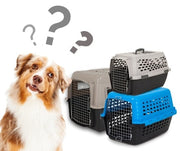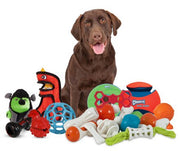How to Properly Fit Prong & Chain Collars

Whether you’re a man or woman, you probably tote a wallet or handbag to fit all of your belongings from day to day. If your wallet or handbag is too bulky or too small, it makes for an uncomfortable fit. Now, we haven’t seen any pets toting around a wallet or handbag these days, but we have seen our share of ill-fitting collars and leashes, especially ones of the prong or chain variety.
Our Patented Comfort Design
Petmate® offers a wide selection of durable and comfortable prong and chain collars. We have carefully designed all of our collars, leashes and harnesses with your pet’s comfort in mind. Our Comfort Chain Collars & Leashes feature nylon woven through the chain to ensure that this patented training tool is comfortable yet effective.
Prong & Chain Fitting
While these types of collars are specifically designed for training your dog to be obedient, by no means should your dog ever feel discomfort from the collar or harness. Unfortunately some trainers use these collars inappropriately to correct or punish the dog for unwanted behavior, thus causing these products to be seen in a negative light.
When used correctly, these training tools can help your dog remember to associate the collars, leashes and harnesses with positive feelings.
Chain collars are constructed of metal links that are designed to help control your dog by tightening up around your dog’s neck. The proper fitting for this chain is to sit high up on your dog’s neck, just behind his ears.
Prong collars include a control loop that’s attached to the leash. This loop fits around your dog’s neck and is made of fang-shaped metal links or prongs, with blunt-like points. The size of the prong links should be appropriate for your dog’s size.
This prong variety should sit high up on your dog’s neck, just behind his ears. The fit should be snug so that the prong links don’t shift to the front of your dog’s neck and accidentally pinch your dog’s trachea.
To ensure that you’re using the chain or prong collar in the appropriate manner, please contact a seasoned obedience dog trainer in your area, as inappropriate use of this product could cause injuries to blood vessels in your dog’s eyes, trachea, and esophagus as well as nerve damage and can even be fatal.
Previous article

Next article

Related posts
View all-

How to Keep Your Pet Calm During Thanksgiving
Thanksgiving is a time for family, friends, and food, but for our pets, the holiday can be overwhelming. The sudden change in routine, unfamiliar faces and scents, and increased noise can trigger significant stress. Understanding why your pet might feel anxious is the first step toward creating a peaceful holiday experience for everyone, including your furry family members. This guide offers calming tips for pets and practical solutions to ensure your dog or cat feels safe and secure during the festivities.
Read Article -

Top Travel Essentials for Pets This Holiday Season
Holiday travel often means bringing the whole family along, and for many of us, that includes our furry companions. Preparing for holiday pet travel is about more than just packing a bag; it's about ensuring your pet's safety, comfort, and happiness from the moment you leave home until you return. A little planning helps reduce stress for both you and your pet, making the journey a positive experience for everyone involved.
Read Article -

Best Leashes and Collars for Daily Walks: A Pet Parent’s Guide
A daily walk with your dog isn't just a chore—it's a chance to bond, explore, and stay active together. The right leash and collar can make every walk safer and more enjoyable for both of you. With numerous styles and materials available, it's essential to find gear that suits your dog's needs and your lifestyle.
Read Article



